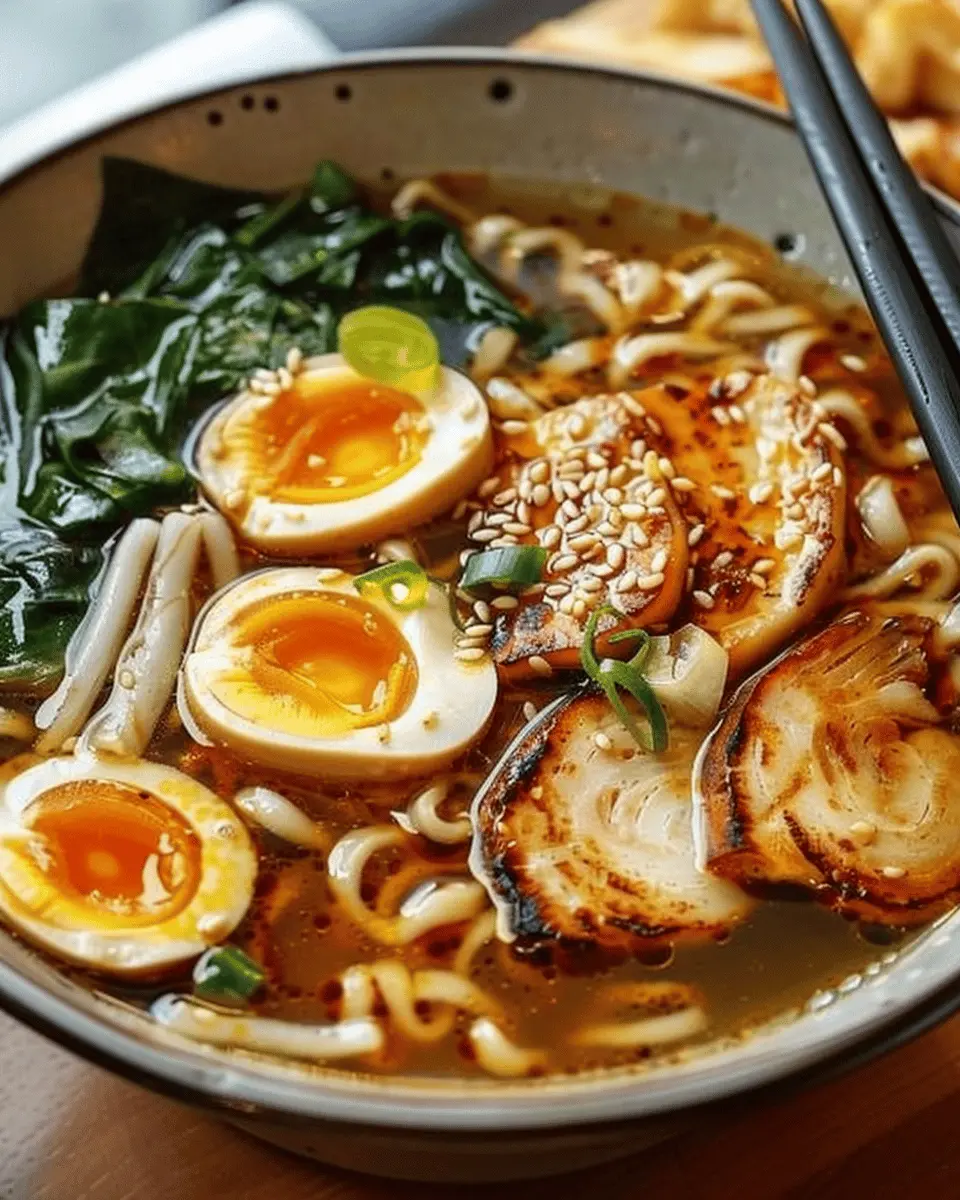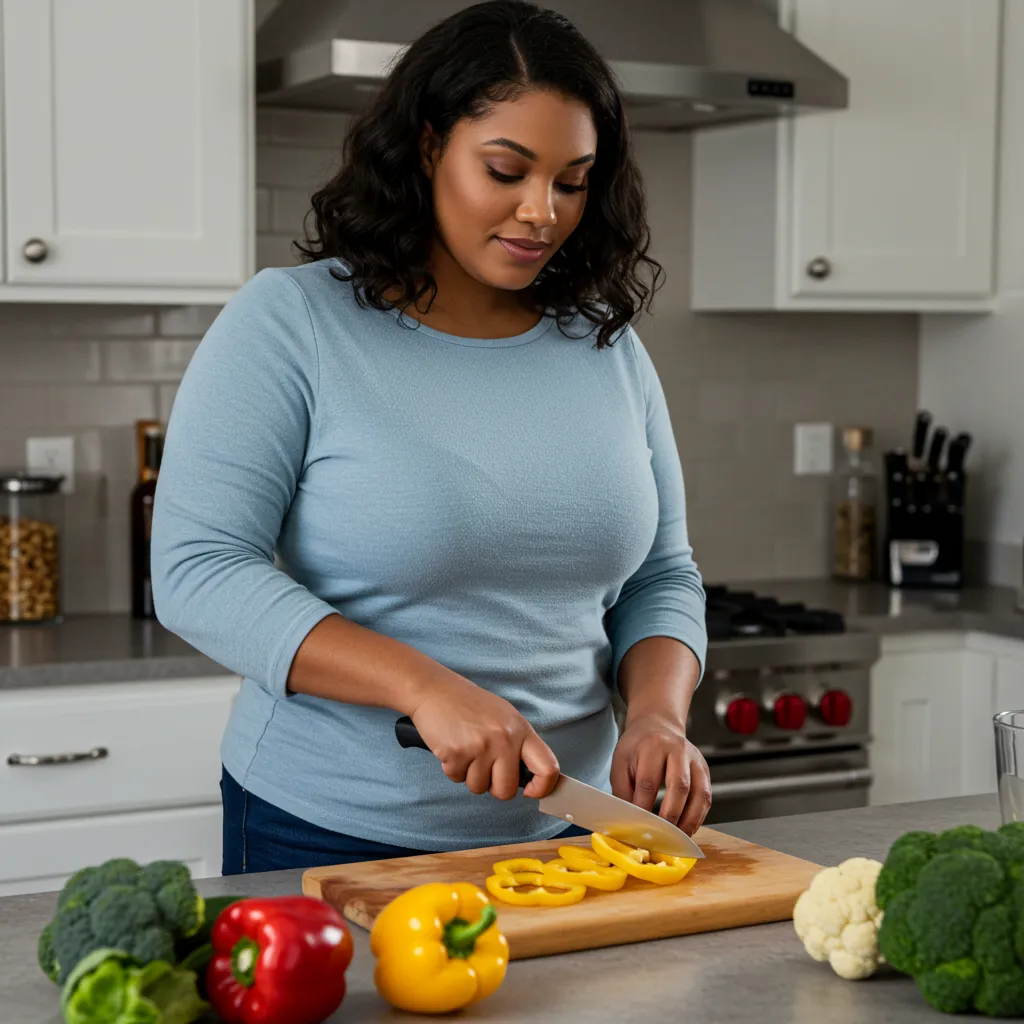Introduction to Homemade Ramen
Why Homemade Ramen is Better Than Takeout
If you’ve ever slurped down a bowl of ramen from your favorite takeout spot, you know how satisfying it can be. But have you ever tried making homemade ramen? Trust us, it’s a game-changer! When you create ramen in your own kitchen, you’re not just making a meal; you’re crafting an experience.
Takeout ramen often lacks customization, often swimming in mediocre broth and pre-packaged toppings. With homemade ramen, you have control over every single ingredient. You can experiment with different broths—maybe a rich beef bone broth or a light miso base. Plus, think of all the toppings! From fresh vegetables to the savory goodness of Turkey Bacon or Chicken Ham, the possibilities are endless.
Cooking at home can even be more budget-friendly. While a bowl from a restaurant may set you back $15 or more, replicating that experience at home can cost you just a fraction of that. And don’t forget about the health aspect. You can avoid unhealthy additives and preservatives that often lurk in takeout meals. It’s a win-win!
The Joy of Creating Your Own Flavors
One of the most thrilling aspects of making homemade ramen is the freedom to create flavors that resonate with your palate. Are you a fan of spicy food? Toss in some chili oil or Sriracha to kick things up a notch. Prefer something more fragrant? Experiment with miso or sesame oil for an aromatic twist.
Cooking isn’t just about feeding your body; it’s about feeding your soul. Each bowl of ramen becomes a canvas for your culinary creativity. Picture this: you’re standing in your kitchen, surrounded by fresh ingredients, and you’re free to mix and match until you find your perfect flavor profile.
Thinking of tackling homemade ramen for the first time? Start small with a simple broth and basic toppings, then gradually expand your repertoire. As you get comfortable, don’t hesitate to look for inspiration online. Websites like Serious Eats or Bon Appétit can be treasure troves of ideas for your next ramen adventure.
Now that we’ve piqued your interest, are you ready to dive into the homemade ramen revolution? Your taste buds won’t regret it!

Ingredients for Homemade Ramen
Essential ingredients for a flavorful broth
Creating a rich, homemade ramen broth is the heart of your dish. Here’s what you’ll need:
- Beef bones: They add depth and richness, essential for a satisfying broth.
- Aromatics: An onion, a few garlic cloves, and fresh ginger will infuse vibrant flavors.
- Soy sauce: A must-have for that umami kick, helping to round out the taste.
- Miso paste: For an extra layer of flavor, consider adding a spoonful – it works wonders!
Don’t forget to simmer your broth for hours. This patience pays off when you taste the sumptuous result!
Must-have ramen toppings
Toppings are where you can really personalize your homemade ramen! Here are some essentials:
- Turkey bacon or chicken ham: These give a savory touch without the heaviness of pork.
- Soft-boiled eggs: A perfectly cooked egg adds richness and texture.
- Fresh herbs: Chopped green onions, cilantro, or even basil can brighten up your bowl.
Experiment! The toppings can turn your ramen into a culinary adventure. For more inspiration, check out resources like Serious Eats for flavorful ideas. Enjoy your journey into the world of homemade ramen!
Preparing Homemade Ramen
Crafting a delicious bowl of homemade ramen may feel like a daunting task, but with the right approach and a little patience, you can create a dish that rivals any ramen joint in the city. Let’s dive into the steps you’ll need to take, ensuring you have a satisfying and flavorful bowl to enjoy.
Gather All Your Ingredients
Before you start cooking, it’s essential to gather all your ingredients. This not only streamlines the cooking process but also ensures you won’t have to run to the store mid-recipe. For our homemade ramen, you’ll need:
- Noodles: Look for fresh ramen noodles for the best texture. Dried noodles can work too, but fresh is preferred.
- Protein: Chicken (including chicken ham), turkey bacon, or beef will give great depth to your broth.
- Mushrooms: Shiitake or cremini mushrooms add a lovely umami flavor.
- Broth: Store-bought or homemade chicken broth can serve as your base. If you’re using homemade, make sure it’s rich and well-seasoned.
- Vegetables: Scallions, bok choy, or spinach for that fresh crunch.
- Condiments: Soy sauce, mirin, sesame oil, and chili paste for seasoning and garnish.
Don’t hesitate to browse for fresh ingredients at local farmer’s markets or specialty Asian grocery stores. You can also find great homemade ramen kits online that include essential items.
Sauté the Mushrooms and Chicken
With all your ingredients at the ready, it’s time to elevate their flavors. Heat a couple of tablespoons of oil in a large pot over medium heat.
- Sauté the mushrooms until they are golden brown. This should take about 5-7 minutes. Don’t rush this step; achieving that caramelized flavor is key!
- Add the protein: Season your chicken (or beef) with salt and pepper, and then add it to the pot. Cook until it’s browned on the outside, about 5 minutes more.
This step not only builds flavor for your homemade ramen but also adds a rich texture to the soup.
Prepare the Broth
Now that your meat and mushrooms are perfectly sautéed, it’s time to prepare your broth.
- Pour in your chicken (or beef) broth, bringing it to a simmer.
- Stir in soy sauce, mirin, and a drizzle of sesame oil for added depth. This mixture will form the flavorful base of your soup.
- Let it simmer for 10-15 minutes, allowing the flavors to meld together. If you’re curious about the science behind why simmering makes flavors better, consider checking out Serious Eats.
Cook the Ramen Noodles
While your broth is bubbling away, it’s the perfect time to cook your ramen noodles.
- Bring a separate pot of water to a rolling boil.
- Add the noodles, cooking according to package instructions (usually 2-4 minutes for fresh noodles).
- Drain and rinse under cold water to stop the cooking process. This helps keep the noodles from becoming gummy.
This step is key in ensuring your homemade ramen has that perfect al dente bite.
Assemble Your Ramen Bowls
Now for the fun and creative part—assembling your ramen!
- Divide the noodles into bowls.
- Ladle the hot broth over the noodles, ensuring a good mix of mushrooms and meat.
- Garnish your bowls with chopped scallions, sautéed bok choy, or a soft-boiled egg. Chili paste can also be added for a spicy kick.
- Don’t forget to sprinkle a little sesame oil on top for that aromatic finish.
The beauty of ramen is that you can personalize it to your tastes. This is where your creative juices can flow! Whether you’re fond of a punchy chili or a dousing of soy sauce, make it your own.
With each step, you’re one step closer to a sumptuous, homemade bowl of ramen that’s both satisfying and nourishing. Get ready to indulge in the amazing flavors you’ve crafted!

Variations on Homemade Ramen
When it comes to homemade ramen, the magic of customization is where the real fun begins! Whether you’re a dedicated vegetarian or just someone who loves a little spice in their life, there are countless ways to make this dish your own.
Vegetarian Ramen Options
For those who prefer a plant-based approach, vegetarian ramen can be just as satisfying. The foundation remains the same, but swapping in a rich broth made from miso, kombu, and shiitake mushrooms can create a deep umami flavor. Add in some fresh vegetables like:
- Spinach
- Bean sprouts
- Carrots
- Fresh corn
Top it off with a soft-boiled egg or tofu for added protein. You can find inspiring vegetarian ramen recipes on Serious Eats to help you along the way.
Another tip? Don’t skimp on toppings! Green onions, sesame seeds, and a sprinkle of nori can take your homemade ramen from simple to stunning.
Spicy Ramen for Heat Lovers
If you’re a fan of heat, you’re in for a treat! Spice things up by incorporating chili oil or fresh chili flakes into your broth. You can even add a dollop of chili paste or sambal oelek for an extra kick. Try these additions:
- Sriracha drizzled on top
- Spicy kimchi as a side
- Jalapeños or other fresh peppers in your noodle bowl
Consider pairing your spicy homemade ramen with a cool beverage, such as coconut water or a refreshing iced green tea. For more spicy ideas, check out this Chili Pepper Madness guide.
In essence, variations on homemade ramen not only cater to different dietary preferences but also to the adventurous palates of culinary explorers. So why not gather your ingredients and start experimenting today?
Cooking Tips and Notes for Homemade Ramen
How to Achieve the Perfect Soft-Boiled Egg
Making a delectable soft-boiled egg is art and science. Start with fresh eggs and bring a pot of water to a gentle boil. Carefully lower the eggs in, cooking them for exactly 6-7 minutes. Afterward, plunge the eggs into ice water to halt the cooking process. This technique not only yields a beautifully runny yolk but also makes peeling easier. Trust me, a perfectly prepared egg transforms your homemade ramen from good to extraordinary!
Tips for Ingredient Substitutions
Flexibility is key when whipping up your own homemade ramen. If you can’t find traditional ingredients, consider these swaps:
- Broth: Use vegetable or chicken broth for an easy swap with beef broth.
- Noodles: Fresh or dried noodles can replace ramen noodles in a pinch.
- Proteins: Turkey bacon or chicken ham work wonderfully as lighter alternatives.
- Vegetables: Feel free to toss in bok choy, spinach, or any seasonal greens you have on hand.
With these simple tweaks, your homemade ramen will remain flavorful and satisfying! For more ingredient insights, check out this guide on ramen fillings.
Happy cooking!

Serving suggestions for Homemade Ramen
Homemade ramen is a canvas for creativity, and the right accompaniments can elevate your dish from good to extraordinary.
Ideal accompaniments for ramen
When it comes to pairings, think about textures and flavors. Here are some fantastic additions:
- Turkey Bacon: Crispy strips add a savory crunch that complements the softness of noodles beautifully.
- Eggs: Soft-boiled or poached eggs deliver a creamy richness that balances the broth.
- Vegetables: Consider sautéed bok choy, radishes, or sweet corn for a fresh, vibrant touch.
- Broth enhancers: A sprinkle of sesame seeds or a dash of chili oil can give your ramen an exciting kick.
How to enhance your ramen presentation
Visual appeal is crucial! Try serving your homemade ramen in a deep, stylish bowl that showcases the vibrant colors of your toppings. Arrange the ingredients artfully: stack the Turkey Bacon, nestle in the egg, and sprinkle fresh herbs like scallions on top. A drizzle of soy sauce or spicy paste around the edges of the bowl can create a stunning, gourmet look.
For more ideas on enhancing your dishes, check out this food styling guide. This attention to detail not only impresses guests but also makes your own dining experience more enjoyable!
Time Breakdown for Homemade Ramen
When it comes to preparing your own homemade ramen, understanding the time you’ll need is crucial. It not only helps in planning but also in managing your expectations for that perfect bowl of noodles.
Preparation Time
First things first: preparation! You can expect to spend about 20-30 minutes gathering ingredients and prepping your vegetables, proteins, and aromatics. If you’re feeling adventurous, you might even whip up some homemade noodles, adding an extra layer of flavor and texture!
Cooking Time
Now for the fun part—cooking! The actual cooking time is approximately 1 to 1.5 hours. This includes simmering your broth, cooking your chosen proteins (like turkey bacon or chicken ham), and boiling your noodles to perfection. It’s a labor of love, but the delicious outcome is well worth it!
Total Time
In total, you’re looking at about 1.5 to 2 hours from start to finish. This might seem like a bit of a time investment, but trust me, as you savor that rich, homemade flavor, you’ll realize it was every minute well spent. For more tips on perfecting your ramen experience, check out sources like Serious Eats where they dive deep into broth techniques and noodle-making secrets.
Nutritional facts for Homemade Ramen
When you whip up a delightful bowl of homemade ramen, it’s not just about the comforting flavors—it’s also good for you!
Calories per serving
On average, a serving of homemade ramen contains about 400-600 calories, depending on the ingredients you choose. This makes it an energizing meal that keeps you fuller for longer without the guilt.
Key nutrients
Homemade ramen is packed with essentials:
- Protein: With toppings like turkey bacon or chicken ham, you’ll get a healthy dose of protein to support your muscles.
- Carbohydrates: Noodles provide vital energy; opt for whole grain for added fiber.
- Vitamins: Adding vegetables like bok choy or spinach boosts vitamins A and C, which are crucial for your immune system.
For more detailed nutritional insights, check out resources like NutritionData and MyFitnessPal. Balancing flavors and health is what makes this homemade ramen so appealing!
FAQs about Homemade Ramen
Can I make ramen broth ahead of time?
Absolutely! Making your homemade ramen broth ahead of time is a fantastic way to save on prep work during the week. In fact, many chefs recommend letting your broth sit to deepen the flavor even further. You can cook a large batch, let it cool, and refrigerate it for up to a week. For longer storage, consider freezing it in portions; when you’re ready to enjoy, simply thaw and reheat.
What other toppings work well with ramen?
The beauty of homemade ramen lies in its versatility. While traditional toppings include sliced beef, green onions, and soft-boiled eggs, you can get creative! Consider adding:
- Turkey bacon for a smoky twist
- Chicken ham for a unique flavor
- Fresh vegetables like bok choy, corn, or mushrooms
- Nori sheets for that authentic touch
- Chili oil or sesame seeds for a little extra kick
Personalize your bowl to suit your taste buds!
How can I store and reheat homemade ramen?
To maintain the quality of your homemade ramen, store the components separately. Keep the broth in a sealed container and the noodles alongside your toppings in the fridge. When it’s time to indulge, heat the broth on the stove and briefly boil or microwave the noodles. Combining the hot broth with the noodles at the end ensures they remain perfectly al dente.
For detailed tips on ingredient freshness, you might want to check out sources like the Food Network and Serious Eats. Enjoy crafting and customizing your ramen experience!
Conclusion on Homemade Ramen
Creating your own homemade ramen is a journey that’s just as satisfying as the meal itself. Imagine the aroma of simmering broth wafting through your kitchen, or the excitement of customizing your toppings exactly to your taste—this is the magic of cooking at home. Studies show that preparing meals from scratch not only nourishes your body but also enhances your well-being and creativity. Embrace the opportunity to experiment with flavors and ingredients, and share your unique ramen creations with friends and family. After all, there’s something special about bonding over a steaming bowl of homemade ramen. So, gather your ingredients and don’t shy away from this delicious adventure!
For tips on optimizing your ingredients, check out this article on cooking techniques that can elevate your meals even further.
PrintHomemade Ramen: Easy Comfort Bowl with Turkey Bacon and Chicken Ham
Enjoy a comforting bowl of homemade ramen featuring savory turkey bacon and chicken ham.
- Prep Time: 10 minutes
- Cook Time: 15 minutes
- Total Time: 25 minutes
- Yield: 2 servings 1x
- Category: Main Course
- Method: Boiling
- Cuisine: Japanese
- Diet: Paleo
Ingredients
- 4 cups chicken broth
- 2 packs ramen noodles
- 4 slices turkey bacon
- 2 slices chicken ham
- 1 green onion, sliced
- 2 boiled eggs
- 1 tablespoon soy sauce
- 1 teaspoon sesame oil
- Salt to taste
Instructions
- In a large pot, bring the chicken broth to a simmer.
- Add the ramen noodles and cook according to the package instructions.
- In a skillet, cook the turkey bacon until crispy, then add chicken ham to heat through.
- Combine the cooked noodles and broth in bowls.
- Top with crispy turkey bacon, sliced chicken ham, green onions, and boiled eggs.
- Drizzle with soy sauce and sesame oil. Adjust salt if needed.
Notes
- For more flavor, add vegetables like spinach or mushrooms.
- Use low-sodium broth for a healthier option.
Nutrition
- Serving Size: 1 bowl
- Calories: 400
- Sugar: 2g
- Sodium: 850mg
- Fat: 18g
- Saturated Fat: 5g
- Unsaturated Fat: 11g
- Trans Fat: 0g
- Carbohydrates: 45g
- Fiber: 3g
- Protein: 25g
- Cholesterol: 200mg
Keywords: Homemade Ramen, Comfort Food, Easy Ramen Recipe













